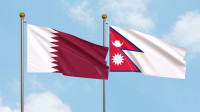National
Central bank paints grim picture of Nepal’s economy
Inflation is rising, BoP is ballooning, remittances are falling and imports surging, Nepal Rastra Bank reports.
Prithvi Man Shrestha
Nepal’s economic indicators do not look promising, as per the latest statistics released by the Nepal Rastra Bank, even as the finance minister has been claiming that everything is hunky-dory.
Inflation is rising, the balance of payment (BoP) deficit is ballooning, inflows of remittances are decreasing, imports are rising and foreign exchange reserves are declining, according to the latest statistics released by the Nepal Rastra Bank (NRB) on Tuesday.
The central bank data showed a worsening picture of the economy, a day after Finance Minister Janardan Sharma said there is no economic crisis in the country.
According to central bank statistics, the country’s inflation averaged at 7.14 percent, which is the highest of the last 67 months, in the first eight months of the current fiscal year 2021-22.
The last time the country’s inflation crossed 7.14 percent was in mid-September 2016, when it stood at 7.9 percent. Officials and experts say the country has also been witnessing a surge in inflation due to the rise in global prices of commodities, including petroleum products and food items.
Petroleum products are the country’s largest import items accounting for 14 percent of Nepal’s entire import volume, according to the Trade and Export Promotion Centre. Besides inflation, indicators particularly related to the external sector (international economic transactions) of the economy have been worrying.
For example, the balance of payment (BoP) deficit has ballooned to Rs258.64 billion. BoP, also known as balance between the money coming in and going out, has been in deficit since the early months of the current fiscal year due to surging imports.
On the other hand, remittance inflows decreased by 1.7 percent to Rs631.19 billion in the review period. Remittances are Nepal’s largest source of foreign exchange.
With imports surging and remittances falling, foreign exchange reserves have continued to decline. As of the first eight months of the current fiscal, the country’s foreign exchange reserves dropped 16.3 percent to Rs1,171 billion in mid-March 2022 from Rs1,399.03 billion in mid-July 2021, according to the central bank.
The available reserves are sufficient to sustain imports of goods and services for just 6.7 months against the central bank’s policy of maintaining the reserves to sustain imports for at least seven months.
Officials and experts say that the indicators prove that all is not well with the economy with the external sector looking vulnerable.
As an import-dependent country, Nepal should have a sound external sector—particularly the country should have enough foreign exchange reserves to buy essential consumer and industrial goods, according to them.
Ram Prasad Gyawali, professor of economics at the Tribhuvan University, said that the country’s economy was headed for a crisis because of worsening external sector indicators but has not yet reached a critical situation.
“All external sector indicators, including trade deficit, remittance, service imports and BoP, are negative,” said Gyawali, who is also former head of the Central Department of Economics at the university.
Similar is the reading of Achyut Wagle, professor at the Kathmandu University School of Management. He told the Post that the country’s economy is already in crisis but has not yet reached the level that Sri Lanka is currently at.
“High trade deficit, which is supposed to reach $18 billion this fiscal year, ballooning BoP deficit and surging debt liability have emerged as major risks to the economy,” he said.
The country’s debt to GDP ratio has reached over 40 percent as of the second quarter of the current fiscal year, according to the Public Debt Management Office. “If we continue to accumulate debts and use them in vanity projects like Sri Lanka did, growing debts could emerge as a huge problem for the country in the future,” said Wagle.
Indications were already there about a possible crisis in the external sector as imports were surging, BoP deficit was widening and foreign exchange reserves were depleting since the start of the current fiscal year.
But the government continued to allow imports of everything unrestrained and excessive lending by banks and financial institutions fueled the imports.
Though Finance Minister Sharma has been complaining that the central bank failed to act despite credit flows, the private sector increasing by over 30 percent against the target of 19 percent, the government also didn’t take any move to control imports in the early months of the current fiscal year.
Sharma instructed the revenue staff to increase revenue substantially from regular growth rate. In August 2021, he had asked for an action plan from tax officials to double the revenue.
“The government’s focus on boosting revenue earnings through imports also contributed to the surge in imports which have brought the current situation,” said Gyawali.
Late last year, the government and the central bank started taking certain indirect measures to control imports. In late November last year, the customs department started seizing gold imported in the form of jewellery exceeding the legal limit.
In December last year, the central bank unveiled a new policy making it mandatory for importers to keep 100 percent margin amount to open a letter of credit for importing 10 types of listed goods.
Importers of motorcycles, scooters and diesel-powered private automobiles also have to maintain a 50 percent margin of the total import value. The list of products to be encouraged for imports were increased to 47 in February this year. The central bank also adopted the policy luring non-resident Nepalis to open accounts in Nepali banks in foriegn currencies.
But these measures are yet to bring significant gains for the economy. “The number of measures to control imports and the outflow of foreign currencies stopped the situation from deteriorating but there has not been significant improvement in economic indicators,” said Prakash Kumar Shrestha, chief of economic research department at the central bank.
“For example, foreign exchange reserves are adequate to sustain imports for 6.7 months in the eighth month of the current fiscal year, which was the same in the seventh month too.”
Though overall foreign exchange reserves declined in the eighth month, the rate of decline came down. One of the reasons, according to central bank statistics, is that inflows of remittance increased substantially in the eighth month of the current fiscal year.
The country received Rs91.2 billion in remittances in Falgun (mid-February to mid-March), which is an 18-month high inflow in a single month since Bhadra (mid-August-mid-September) 2020 when the country had received remittances amounting to Rs93.1 billion.
“In short, the economy has stopped from going further downhill but it is yet to recover,” said Shrestha.
Despite major economic indicators remaining grim, officials and experts say the Nepali economy is unlikely to see the situation like that in Sri Lanka. They said that although the economy appears to be heading in the direction of Sri Lanka, there are certain differences between the conditions of the two countries and this will stop the country from becoming another Sri Lanka.
“The main reason behind the Sri Lankan crisis is unproductive national debts, loss of credibility in the government and no contingency plan to make up for the loss of tourism income,” said Wagle.
“Despite rising debts, we still have room to take more debt and the average interest rate of our debt (both external and internal) is just over four percent compared to six percent in Sri Lanka.”
Amid the economic crisis, Sri Lanka has already decided to suspend external debt payments. Its debt to GDP ratio stood at 119 percent in 2021, according to the International Monetary Fund.
Gyawali also believes that the country is unlikely to face the Sri Lankan situation although the economy is moving in that direction. “Sri Lanka is facing multidimensional problems while our problem is mostly related to rising imports,” said Gyawali.
“High foreign debt, food crisis due to reduced agriculture production caused by the haphazard decision to move to organic farming also contributed to the worsening of Sri Lankan economy when tourism was battered by the Covid-19 pandemic.”
The terrorist attacks of 2019 and the Covid-19 pandemic hit Sri Lankan tourism and its foreign exchange earning, the island nation didn’t have any contingency plan to increase foreign exchange to buy essentials and enable it to pay surging external debts.
“We also don’t have a contingency plan against a potential reduction in remittances. So, our economy is also vulnerable to slump in remittances.”




 17.12°C Kathmandu
17.12°C Kathmandu













%20(1).jpg&w=300&height=200)

